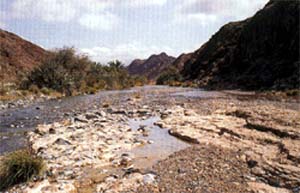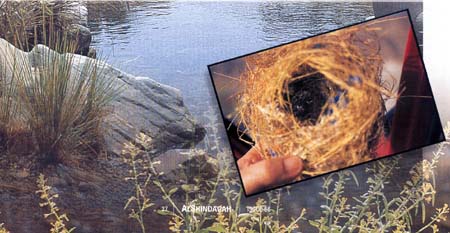|
Among the many different trips that
can be made into the range of the Hajar Mountains, the
track that leads to the oasis of Shiis is one of my
favourites. The beginning of the road is on the east
coast and leads first through the tiny Omani enclave of
Madha, that lies in a bend of the wadi, so that the road
dips down to wadi level both at the entrance and at the
exit of the village. In times of rain this road may not
be passable. The oasis that lies at the back of the
village is a botanical gem, with some rare plants such
as Dalecampia scandens and Crotalaria retusa
having been
recorded.
Just beyond where the road crosses the wadi bed the
second time is a place where the beautiful Tecomella
undulata tree grows in abundance on both sides of the
road. Its large trumpet-like flowers grow straight from
the branches, virtually without a stem. At this site the
government has made a recreational area with picnic
tables and shades. When the river is in spate, there is
no prettier place to spend a Friday!
But for the real adventurer the better parts lie beyond
this site. First one has to pass through a newly
constructed settlement, and then the track crosses pass
after pass, forever deeper into the mountains. The rocks
along the road are so varied and colorful that almost
anyone would want to become a geologist. In fact, the
Hajar mountains are of great interest to professional
geologists, because this is one of the few places on
earth where volcanic rocks that were once at the bottom
of the ocean can be studied at the surface without a
dense covering of vegetation. Here a cascade of white
"streams" is made up out of calcite deposits, there a
seam of mica glistens like diamonds. Dark red chert lies
side by side with sparkling gold muscovite. Even garnet
has been found here. Once I had the good luck to see the
rocks when it was raining. The colors show much brighter
when the rocks are wet
Side wadis tempt you for a walk past blue-green pools.
There are many places to go for a cool swim.
Unfortunately some people that enjoyed this privilege
have left graffiti on the rocks and garbage in the wadi
bed. I can never believe that anyone can do that. How
much more fun to leave a place exactly as you found it:
clean, pretty and peaceful.
On one rather hot early summer walk, I found a low cave
with hundreds of butterflies. This is where the large
White-edged Rock Brown (Hipparchia parisatis) survives
the summer. The wadis are lined with Oleander bushes and
Saccharum reeds and many small plants have found a niche
between the boulders in the wadi bed. Dragonflies flit
by with speeds up to 70 km an hour, damselflies can be
seen in pairs on twigs and grasses. Once I found an
extraordinary creature between the rocks here. At first
I though it was a woolly spider, but when I focused in
with my close-up lens I saw it was a very small camel
spider. Its body was orange and its legs were very furry
and black. As I tried to take a picture, its front two
legs came up over its head. It was a defensive gesture,
no doubt, but it looked as if it was covering its eyes
in order to hide from this threatening giant above him.
I quickly left it to live its life in peace.
From one of the high passes there is a sudden splash of
green to be seen, nestling amidst the reddish-brown and
black rocks. This is the oasis of the Bani Humayd. The
track that leads between the gardens is lined with very
old fig trees (Ficus cordata) and "sidr" trees (Zizyphus
spinachristi). These latter trees have sweet-smelling
flowers that are nutritious fodder for goats, while the
small yellow fruits that come later are enjoyed by the
farmers themselves. They are like small sour apples. If
you take care not to trample the crops and destroy
irrigation channels and stone walls, the farmers welcome
you to rest in the shade of the palm trees. Between the
sorghum plots, the date palms and the citrus trees,
there are many wild flowers to discover and enjoy. The
delicate white flowers of the aromatic basil (Ocimum
basilicum) vie for place with the yellow stars of
Urospermum picroides and the tall twigs of the jute
plant Corchorus trilocularis. Small maidenhair ferns (Adiantum
capillus-veneris) line the water channels. In early
summer the farmers sing as they work in the palm groves,
but most of the time the silence is carried only by the
tinkle of water and the song of birds.
On, on we travel across rough boulder beds to where a
waterfall bars further vehicle use. This is the oasis of
Shiis, well advertised by the sudden appearance of
electric street lamps in the wadi bed! The pools at the
foot of the waterfall are another favourite picnic place
and sadly also badly polluted by careless visitors. It
is possible to walk through the palm groves on the left
to the top of the waterfall and from there follow the
course of the wadi upstream for many more miles. The
people of the village object to anyone taking a swim in
this upper part of the wadi - understandably, as their
drinking water comes from here. You can see the channel
and pipes that lead the water across the high cliffs to
the houses that are built precariously along them.
Among the rocks of the walls that surround the fields,
the large lizard Lacerta jayakari finds its home. This
is one of the two species of reptiles that are
indigenous to the Hajar mountains (the other is the
smaller brilliantly coloured Lacerta cyanura, with its
bright blue chin, belly and tail). Indigenous means that
the animal does not occur anywhere else in the world.
With its large size (up to 60 cm) and its beautiful
mottled slate blue skin, Jayakar's lizard is certainly a
creature worthy of protection. Fortunately, as far as I
know, people do not persecute it for any reason, and
there seem to be plenty of them around. Another reptile
often seen in this habitat is the slender and fast Wadi
racer, Coluber rhodorhachis. This rear-fanged snake is
not dangerous to people, as its fangs are set far back
in its mouth so that it cannot grasp anything very
large, and the poison is only fit to kill its prey of
fishes, toads and small mammals. The non-dangerous
snakes can be distinguished from the more dangerous
vipers by the shape of their body and head as well as by
their behaviour. The heads of vipers are triangular,
with a well-visible neck, and their bodies are usually
quite thick. The fast, thin snakes have bullet-shaped
heads and no distinguishable neck. Vipers are usually
slow-moving, rather lazy reptiles. It is not unusual to
step across a viper without even noticing it (it
happened to me and to other wadi walkers). The snake
only strikes if it is being hurt or if it feels
threatened. The poison is potent and an immediate
evacuation to a hospital is necessary. With treatment
the bite is unpleasant and painful, but without
treatment it can be fatal.
On one visit I found an interesting example of nature
recycling: a deserted bird's nest had been taken over by
a colony of paper wasps. The cells of the wasp's nest
were suspended from the arching top of the globular nest
and profited from its shade.

Bird-spotters can have a good time on this trip too, as
there are so many different habitats: gardens, open rock
and wet streams. The most interesting bird that I ever
spotted was a Hammerhead stork, but I am told by the
birding experts that it is very unlikely that this
African bird made it this far north and east, so it was
probably a figment of my imagination.
Even though the way back follows the same route, the
views are different and many different plants catch your
eye. With late afternoon back lighting large flowering
plants like Cleome rupicola or Lavandula subnuda look
especially pretty. A last visit to a deep pool to wash
away the dust of the trip and you are ready for the long
ride home.
|
